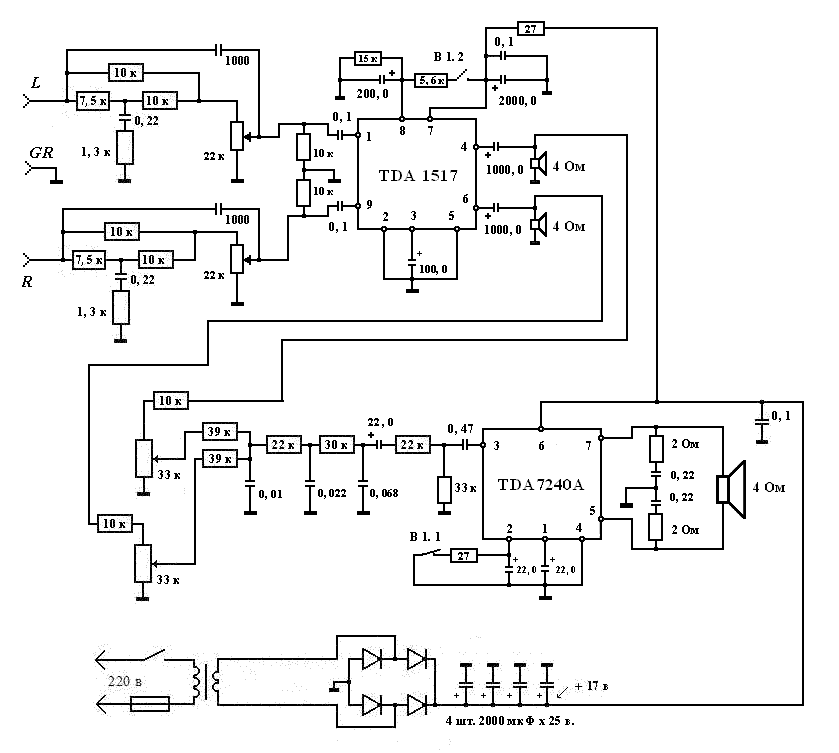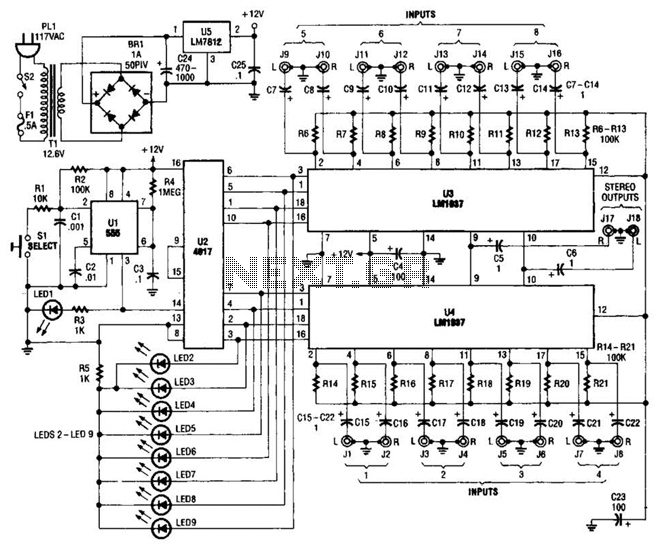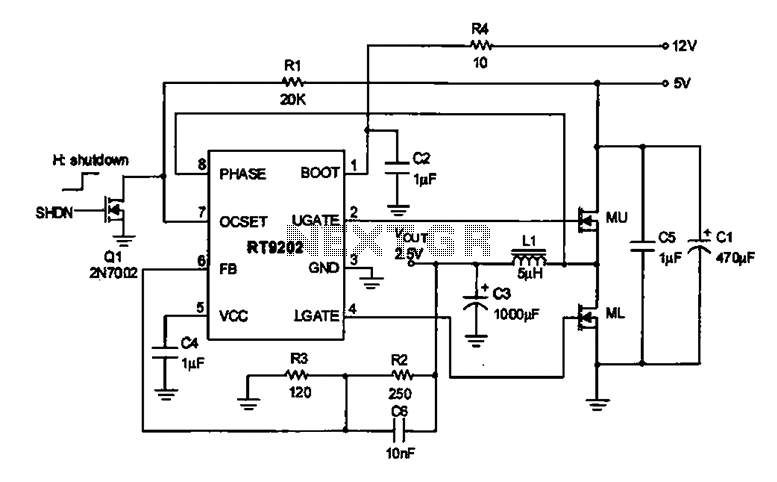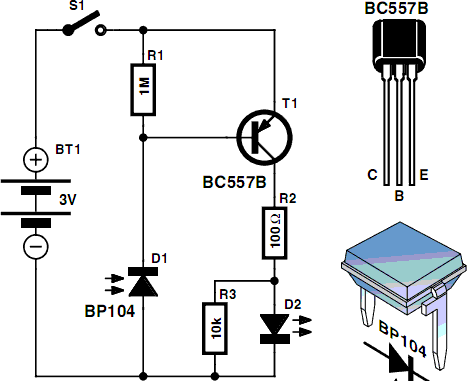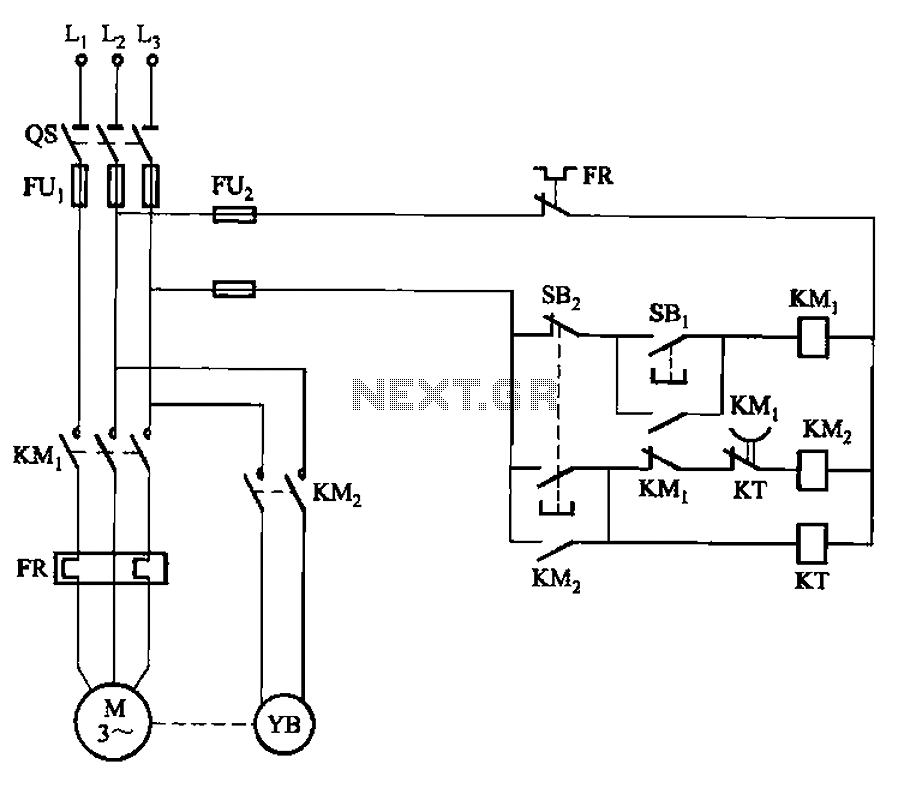
Digital Alarm Speedometer Circuit
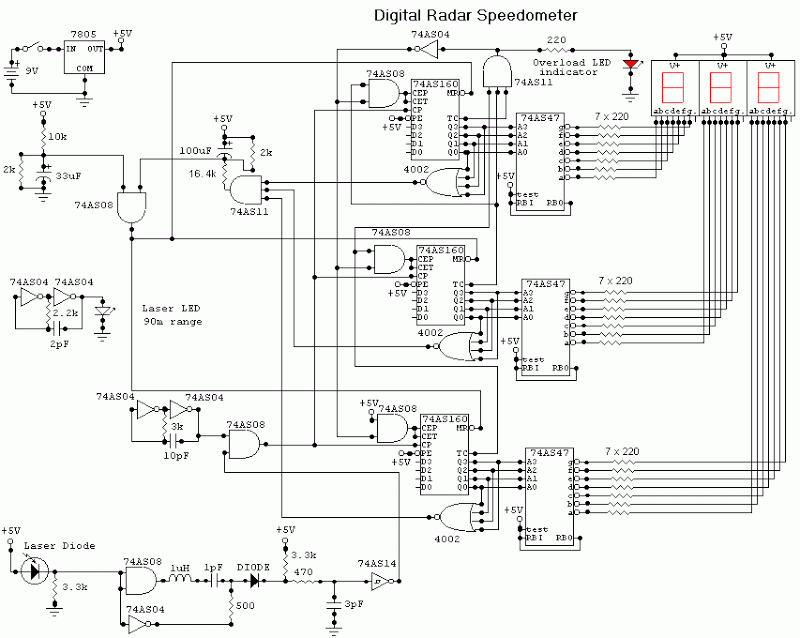
This digital alarm speedometer circuit allows for the measurement of the acceleration of any moving object, particularly cars and other vehicles. The acceleration is displayed in kilometers per hour (KPH) with a three-digit display. The system operates using laser reflection; it emits laser radiation towards the object, which then reflects the laser radiation back to the radar. To accurately measure a vehicle's acceleration, the radar must be positioned in front of the vehicle, meaning the vehicle must be approaching the radar. The front of the radar is designed to point towards the vehicle. The device resembles a pistol and incorporates a laser LED and a laser diode, both equipped with lenses. The laser LED can project a beam of light up to a distance of 90 meters (295 feet). It is crucial that the range of the laser LED is 90 meters; otherwise, the acceleration will not be measured accurately. The laser diode, which detects the light signal emitted by the laser LED, must be capable of recognizing the light of the same color as that emitted by the laser LED. The laser diode and the laser LED are positioned adjacent to each other and are protected by a transparent pane, both being located at the front of the radar and directed outward. The circuit is powered by a 9V battery and features a Single Pole Single Throw (SPST) switch to control its power state. The display, or speed indicator, is located at the rear of the radar, just to the right of the alert LED indicator. All logic components used in the circuit should be from the 74AS series and of TTL type, as they have a short response time (less than 1.7 ns) and support high frequencies (over 200 MHz). The device can measure the speed of an object moving between 0 to 999 km/h. Beyond this speed, the alert LED indicator will activate, and the display will continue to show "999." The speed is displayed for 3 seconds, after which it resets to "zero" (0).
The digital alarm speedometer circuit operates on the principle of laser reflection, utilizing a laser LED to emit a coherent light beam toward the target vehicle. The emitted light reflects off the vehicle and is captured by the laser diode, which is sensitive to the wavelength of the emitted light. The precise alignment of the laser LED and diode is crucial to ensure optimal performance and accurate readings. The circuit's design incorporates a microcontroller based on the 74AS series logic family, which provides high-speed processing capabilities essential for real-time speed measurement.
The SPST switch allows the user to turn the device on and off easily, conserving battery life when not in use. The display module, positioned conveniently for user visibility, updates the speed measurement every second, providing a clear indication of the vehicle's acceleration. If the speed exceeds 999 km/h, the system indicates this limit with the alert LED, ensuring that the user is aware of the maximum measurable speed. The device's ability to reset the display to zero after three seconds enhances its usability, allowing for continuous monitoring of multiple vehicles without manual intervention.
Overall, this digital alarm speedometer circuit is a sophisticated tool for measuring vehicle acceleration, combining advanced optical technology with efficient electronic components to deliver accurate and timely speed readings.This Digital Alarm Speedometer Circuit. It allows us to appraise the acceleration of any article moving, abnormally cars and added vehicles. The acceleration is affected in kilometers per hour (KPH). Its affectation has three digits. This alarm works with the laser reflexion. It sends laser radiation to the article and this article reflects the la ser radiation to the radar. To appraise the acceleration of a vehicle, we charge be in advanced of it. In added words, the agent charge appear in our direction. The advanced of the alarm charge point the advanced of the vehicle. The alarm has the appearance of a pistol. In this radar, it has a laser LED and a laser diode. Both accept a lens. The laser LED can accelerate a atom of ablaze to a ambit of 90 m (295 ft). It`s actual important that the ambit ambit of the laser LED is 90 m, if not, the acceleration will not be affected properly. The laser diode, which receives the ablaze arresting by the laser LED, charge be able to ascertain the ablaze which is aforementioned blush as that emitted by the laser LED.
The laser diode and the laser LED charge be placed one beside the other. They are adequate by a brave pane. They charge be placed at the advanced of the alarm and point the outside. The alarm is powered by a 9V array and it has a SPST about-face to ascendancy its ability state. The display, or the acceleration indicator, is placed at the rear of the radar, aloof on the appropriate of the afflict LED indicator. All the argumentation apparatus of the ambit charge be of the 74AS alternation and TTL type. Because they accept abbreviate time of acknowledgment (less than 1. 7 ns) and accept aerial abundance supports (more than 200 MHz). The alarm can appraise the acceleration of an article affective amid 0 to 999 km/h. Afterwards this speed, the afflict LED indicator will about-face on and the "999" will still displayed.
The alarm displays the acceleration during 3 seconds, afterwards this time, it displays "zero" (0) 🔗 External reference
The digital alarm speedometer circuit operates on the principle of laser reflection, utilizing a laser LED to emit a coherent light beam toward the target vehicle. The emitted light reflects off the vehicle and is captured by the laser diode, which is sensitive to the wavelength of the emitted light. The precise alignment of the laser LED and diode is crucial to ensure optimal performance and accurate readings. The circuit's design incorporates a microcontroller based on the 74AS series logic family, which provides high-speed processing capabilities essential for real-time speed measurement.
The SPST switch allows the user to turn the device on and off easily, conserving battery life when not in use. The display module, positioned conveniently for user visibility, updates the speed measurement every second, providing a clear indication of the vehicle's acceleration. If the speed exceeds 999 km/h, the system indicates this limit with the alert LED, ensuring that the user is aware of the maximum measurable speed. The device's ability to reset the display to zero after three seconds enhances its usability, allowing for continuous monitoring of multiple vehicles without manual intervention.
Overall, this digital alarm speedometer circuit is a sophisticated tool for measuring vehicle acceleration, combining advanced optical technology with efficient electronic components to deliver accurate and timely speed readings.This Digital Alarm Speedometer Circuit. It allows us to appraise the acceleration of any article moving, abnormally cars and added vehicles. The acceleration is affected in kilometers per hour (KPH). Its affectation has three digits. This alarm works with the laser reflexion. It sends laser radiation to the article and this article reflects the la ser radiation to the radar. To appraise the acceleration of a vehicle, we charge be in advanced of it. In added words, the agent charge appear in our direction. The advanced of the alarm charge point the advanced of the vehicle. The alarm has the appearance of a pistol. In this radar, it has a laser LED and a laser diode. Both accept a lens. The laser LED can accelerate a atom of ablaze to a ambit of 90 m (295 ft). It`s actual important that the ambit ambit of the laser LED is 90 m, if not, the acceleration will not be affected properly. The laser diode, which receives the ablaze arresting by the laser LED, charge be able to ascertain the ablaze which is aforementioned blush as that emitted by the laser LED.
The laser diode and the laser LED charge be placed one beside the other. They are adequate by a brave pane. They charge be placed at the advanced of the alarm and point the outside. The alarm is powered by a 9V array and it has a SPST about-face to ascendancy its ability state. The display, or the acceleration indicator, is placed at the rear of the radar, aloof on the appropriate of the afflict LED indicator. All the argumentation apparatus of the ambit charge be of the 74AS alternation and TTL type. Because they accept abbreviate time of acknowledgment (less than 1. 7 ns) and accept aerial abundance supports (more than 200 MHz). The alarm can appraise the acceleration of an article affective amid 0 to 999 km/h. Afterwards this speed, the afflict LED indicator will about-face on and the "999" will still displayed.
The alarm displays the acceleration during 3 seconds, afterwards this time, it displays "zero" (0) 🔗 External reference
